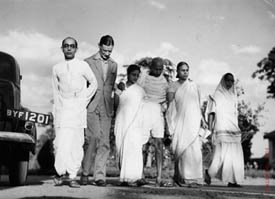
A Quaker, prevented by his religious beliefs from doing anything remotely exciting or enjoyable, he and his brothers were drawn to birdwatching like moths to a flame. Born in London, educated at Cambridge, he was in his youth one of the pioneers of Dungeness when it was nothing but a wasteland of Stone Curlews and Kentish Plovers. He went on to become a teacher, League of Nations, blah blah blah, and is perhaps most famous for his peace-work and his friendship with Gandhi during India's struggle for Independence. In fact, when Gandhi was in jail, he described HG as one of India's best friends. Hung out with Salim Ali. Spent his later life in the USA, continued birding up til his death, even though he couldn't see or hear properly any more. Cool.
He earns his prestigous 'Heroes' medal for his prolific contribution to the early development of sight-based bird recording. Numerous notes in British Birds (http://www.britishbirds.co.uk), contribution to Witherby's Handbook of British Birds and author of the iconic 70 years of Birdwatching. Take this record of a possible Yellow-browed Warbler from Dungeness, 1915. Remember a few miles to the west, gun and taxidermy-based ornithology was in full swing, with George Bristow's shop churning out rarities of spurious provenance and virtually no field-based description. HG was not like that...
British Birds 9: 183-184 (1915)
YELLOW-BROWED WARBLER SEEN IN KENT
On the 24th September 1915, I put a small bird out of a bush on Dungeness shingle, which looked as if it must be a Yellow-browed Warbler (Phylloscopus superciliosus [now inornatus]). It was almost dusk at the time and I lost the bird without getting a very good view of it, though I once heard a note, like the ordinary Willow-Wren's note [Willow Warbler] in general character, but sharper and much shriller.
Fortunately I found it again in the same bush next morning and obtained a much better view. When it first flew out, almost from under my feet, the yellowish colour of the rump attracted my attention, and in consequence I wondered if it were really Ph. proregulus; however, an examination of some specimens kindly lent me by Mr. Witherby convinces me that this is not the case. The eye-stripe was not very conspicuous, and the only time the bird gave me a good view of its wing the side-feathers covered much of the coverts, so I did not see much of the wing-bars; but both these features. as far as I saw them, are in agreement with one or two of the specimens examined. the short tail and regulois appearance were marked as the bird flew, but when it settled it looked just like a small Willow-Wren. I heard the note again three or four times. The bird became rather difficult of access after I had put it up two or three times, and I had to leave it in order to catch the train.
Dr N. F. Ticehurst mentions one or more occasions when this species has been observed in Kent, but no instance of it being obtained is recorded.
H. G. ALEXANDER
Now I'm not sure what that bird was (and I doubt it would get past a modern day County Recorder... 'I regret to say that although your description is suggestive there are one or two features that worry me and therefore...') but notice how this lays down the formula for an honest description, of a wild-bird, alive(!), its call, its behaviour, and the possible conclusion as to id, with caveats and other possibilities. Compare and contrast with the 'a bird was obtained and brought to me...' standard of bird recording prevalent elsewhere at the time. I love the bit about having to go for the train too. Interesting that Ticehurst wasn't aware of any others being obtained, because one (a Hastings Rarity) had been published in BB the year before. He was obviously experimenting with what was to become a long and honourable tradition of BB editorial members forgetting what has just been published in their own magazine.
Horace Gundry Alexander... you had a crap and mildly amusing name, but you were instrumental in developing the modern age of sight-based ornithological recording, and for this I name you a Hero of the Birding revolution, 1st Class.
 HG Alexander (second left), going over the finer points of Yellow-browed Warbler identification with Gandhi and other members of the Indian Ornithological Union
HG Alexander (second left), going over the finer points of Yellow-browed Warbler identification with Gandhi and other members of the Indian Ornithological Union
1 comment:
HGA was also a founder and leading member of the West Midland Bird Club. The Clubs' website has an extract from his autobiography: http://www.westmidlandbirdclub.com/biblio/70Years/WMRes.htm and details of a more recent biography: http://www.westmidlandbirdclub.com/biblio/biblo2.htm#Birds+Bins.
Post a Comment